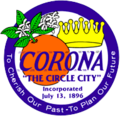Corona, California | |
|---|---|
Top: view of Corona, interchange of Interstate 15 and the 91 Freeway can be seen in the distance; bottom: Corona Historic Civic Center Theater | |
| Nicknames: | |
| Motto: "To Cherish Our Past, To Plan Our Future" | |
 Location of Corona in Riverside County, California | |
Location within Greater Los Angeles | |
| Coordinates: 33°52′N117°34′W / 33.867°N 117.567°W | |
| Country | United States |
| State | California |
| County | Riverside |
| Established | July 13, 1896 [3] |
| Government | |
| • Type | Council–manager [4] |
| • Mayor | Jacque Casillas [4] |
| • Vice Mayor | Wes Speake |
| • City Council | Tom Richins Tony Daddario Jim Steiner |
| • City Treasurer | Chad Willardson |
| Area | |
| 39.96 sq mi (103.50 km2) | |
| • Land | 39.94 sq mi (103.45 km2) |
| • Water | 0.019 sq mi (0.05 km2) 0.27% |
| Elevation | 679 ft (207 m) |
| Population (2020) | |
| 157,136 | |
| • Rank | 3rd in Riverside County 34th in California 161st in the United States |
| • Density | 3,934.2/sq mi (1,519.02/km2) |
| • Metro | 4,224,851 |
| Time zone | UTC−8 (Pacific) |
| • Summer (DST) | UTC−7 (PDT) |
| ZIP codes | 92877–92883 |
| Area code | 951, 909 |
| FIPS code | 06-16350 |
| GNIS feature IDs | 1652691, 2410232 |
| Website | City Government Tourism site |
Corona (Spanish for "Crown") is a city in northwestern Riverside County, California, United States, directly bordering Orange and San Bernardino counties. Its current mayor is Jacque Casillas. At the 2020 census, the city had a population of 157,136, up from 152,374 at the 2010 census. Corona is surrounded by Riverside to the east, Norco to the north and northeast, Yorba Linda to the northwest, Cleveland National Forest and the Santa Ana Mountains to the west, southwest, and south. Several unincorporated communities are along the rest of the city's borders. Downtown Corona is approximately 48 miles (77 km) southeast of Downtown Los Angeles and 95 miles (153 km) north-northwest of San Diego.
Contents
- Etymology
- History
- Indigenous
- Colonial period
- Establishment
- 20th century
- 21st century
- Geography and climate
- Economy
- Top employers
- Demographics
- 2020
- 2010
- Government
- Infrastructure
- Transportation
- Healthcare
- Education
- Nonprofit associations
- Utilities
- Quarries
- Cemetery
- Corrections
- Neighborhoods
- Center City
- Unincorporated communities
- Eastside
- Westside
- Arts and culture
- Performing arts
- Notable people
- Athletes
- Entertainers
- Other
- Sister cities
- See also
- References
- External links
Corona, located along the western edge of Southern California's Inland Empire region, is known as the "Circle City" due to Grand Boulevard's 3 mi (4.8 km) circular layout. It is one of the most residential cities in the Inland Empire, but also has a large industrial portion on the northern half, being the headquarters of companies such as Fender Musical Instruments Corporation, Monster Beverage Corporation, and sports car manufacturer Saleen.




















